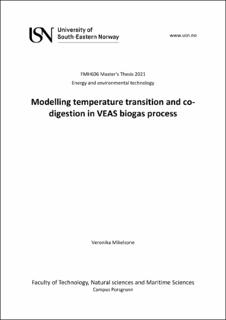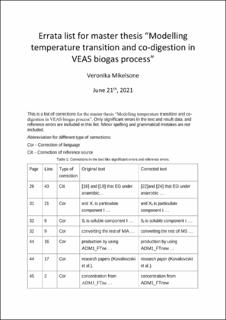| dc.description.abstract | Anaerobic digestion (AD) is a well-established way to stabilise concentrated sludge produced in wastewater treatment (WWT) plants. The benefit of the process is the production of biomethane and digestate that can be used as biofertiliser in land application. AD is a biological process, and many environmental parameters can influence its stability. One way to aid in the prediction and control of the process is to use mathematical modelling. This work aimed to assess the modelling of the transition from mesophilic to thermophilic AD by evaluating microbial adaptation to temperature shift. Also, evaluate the effects of co-substrate addition with the help of simulation. Consider the effect of Thermal Hydrolysis (THP) pre-treatment on AD and substrate. Additionally, assess if a potential increase of energy production by 50% is possible for VEAS.
In this work, a study of AD modelling was done to simulate the transition from mesophilic to thermophilic AD process and co-substrates. Anaerobic Digestion Model No. 1 (ADM1) was used as base model and modified to simulate the temperature transition and evaluate co-digestion. Two models temperature transition models, ADM1_CTM1 and ADM1_FTnew, were tested and evaluated same cases. Model ADM1_FTnew had a better match with data from the two laboratory-scale experiments than ADM1_CTM1. Modelling of additional co-substrate was done by implementing the input parameter for each substrate in ADM1. Four different co-substrates were used, three sludges with different composition and water with carbon-rich source as de-icing fluid (propylene glycol-based). Different scenarios were simulated with different substrates ratios and for two temperature conditions, mesophilic and thermophilic. The simulations with propylene glycol wastewater (PGW) showed a 10% and 11% increase in potential energy production for mesophilic and thermophilic process, respectively, with the organic loading rate (OLR) of propylene glycol containing wastewater (PGW) around 0.47 kgCOD/(m3d). As for additional sludges, the carbon to nitrogen (C/N) ratio was in focus. Three sludges had different C/N ratios that were lower or almost equal to Vestfjorden Wastewater Company (VEAS) sludge C/N ratio of 9, used as the main feed. The simulations showed an increasing concentration of volatile fatty acids (VFA) in the reactors when the C/N ratio was below 9. For simulation with the lowest C/N ratio of 3.7, the average VFA concentration was at 3.2 kgHAc/m3. These high VFA concentrations shows that the C/N ratio of 9 the lowest advisable value for stable process. The highest increase in potential energy production was observed when all co-substrates were added, and OLR was increased from 3.6 to 4.5 kgCOD/(m3·day). The increase was 26% for the mesophilic and 47% for the thermophilic processes.
THP literature review showed a possibility of implementing THP in AD modelling by increasing hydrolysis rate and solubilising particulate components. Though more work needed to estimate simulation parameters for different substrates. | |

